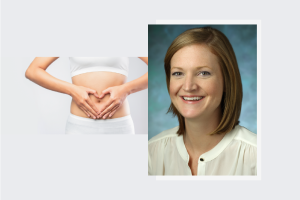
When Mary Austin, PT, DPT, WCS, a pelvic health specialist and assistant professor of physical medicine and rehabilitation at the Johns Hopkins School of Medicine, first envisioned a reusable alternative to disposable pessaries, she wasn’t thinking about launching a company. She was thinking about her patients.
“I’ve been a pelvic health physical therapist for 17 years,” Austin says. “I work with people experiencing urinary, bowel, and sexual dysfunction, and pelvic pain. One day, I looked at a disposable pessary and thought, why isn’t this reusable?”
That question sparked a journey that would take her from the clinic to the innovation ecosystem at Johns Hopkins Technology Ventures (JHTV), where she’s now building a company focused on accessible, over-the-counter pelvic health solutions.
The idea simmered for nearly a decade before a conversation with a patient and a faculty member about their experience with JHTV reignited it. Soon after, a 40th birthday trip with college friends pushed her to create a deadline for herself and finally submit a report of her invention.
That submission led to being connected with Christina DeMur, director of technology development at JHTV, who facilitated collaborations with a team of biomedical engineering students in the Whiting School of Engineering through their Design Team course as well as a team of business school students at the Carey Business School through Life Design Lab, and the idea began to gain traction. Her co-founder, a biomedical engineer, brought FDA clearance experience to the table.
Austin still works closely with the team of biomedical engineering students who have been pivotal in making her vision a reality and was fortunate enough to meet her co-founder through the Design Team program, a biomedical engineer who brings MedTech start up and FDA clearance expertise to complement Austin’s subject matter expertise.
Austin later participated in a pitch competition hosted by JHTV. Winning the 2024 Pitch It On competition was a pivotal moment. “It was validating,” Austin says. “Before that, we had only won two small student competitions. This was the first time we felt like we were really onto something.”
The $20,000 prize helped finalize their prototype and gave the team the confidence to pursue additional mentorship and funding opportunities. “It built momentum,” she adds.
Austin credits mentorship programs as the most transformative part of her entrepreneurial journey. Through JHTV’s Venture Mentorship Program, she was paired with mentors who helped refine her market analysis and revenue models. As a clinician, she possessed deep subject matter expertise but lacked experience in business and marketing.
Her participation in the Equalize program—a national initiative for female faculty founders—is what Austin calls “the most valuable thing I’ve done to date.”
“It was like a mini-MBA,” she says. “I didn’t know what a cap table was. I didn’t know the difference between dilutive and non-dilutive funding. Being in a room full of women made it okay to ask questions.”
With multiple mentors came multiple perspectives. Some advised pursuing a durable medical equipment pathway, but that didn’t align with Austin’s vision for a direct-to-consumer product.
“Being coachable is important,” she says, “but you also must stay true to your original vision. Not all advice is the right advice for your mission.”
Austin’s mission is clear: make pelvic health care more accessible. “Not everyone can get to a physical therapist or a specialist,” she explains. “Especially if you’re not near a major medical center.”
She envisions a product that’s affordable, over-the-counter, and supported by an app that offers instructions, community, and access to providers. “Current websites feel elderly,” she says. “We want something inclusive.”
Inspired by models like TOMS shoes, Austin hopes to eventually offer a buy-one-give-one model to support women in underserved areas globally.
Austin and her team are wrapping up their prototype and preparing for bench testing. Despite limited funding, they’re moving ahead with a small pilot study. To scale (e.g., FDA clearance, manufacturing, and hiring a pre-sub consultant), they’ll need additional capital and are actively pursuing grants, angel investors, and venture capital.
Their timeline is ambitious: secure funding within 6–9 months, achieve FDA 510(k) clearance in 12–18 months, and begin manufacturing by 2027 or 2028. Meanwhile, they’re collaborating with a design team on a second device targeting other types of pelvic floor dysfunction.
Austin’s advice for other clinician-innovators? “Take every meeting. You never know what someone might offer or who they might connect you with.”
And most importantly: “Remember your ‘why.’ This isn’t just about making money. It’s about providing an option that people don’t currently have.”
Austin is building more than a product. She’s building awareness, community, and a future where pelvic health is accessible to all.